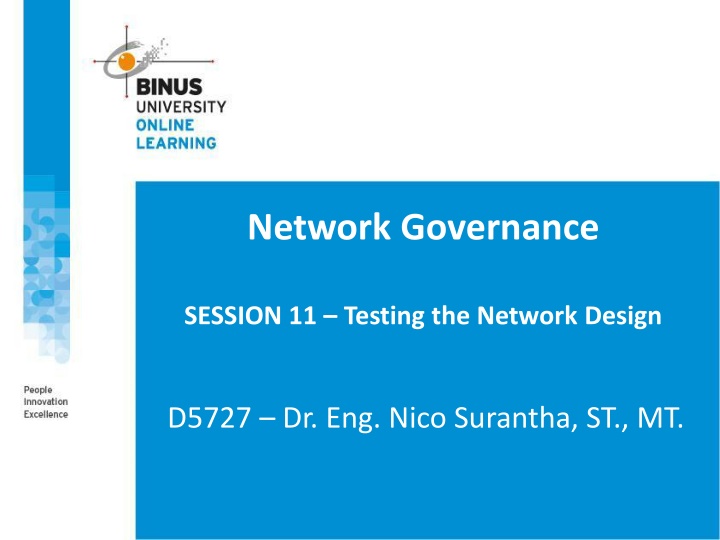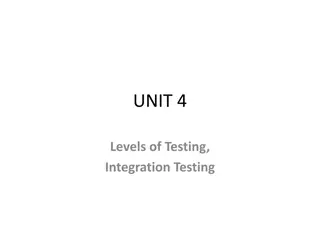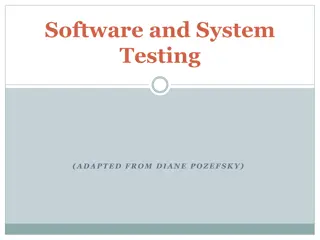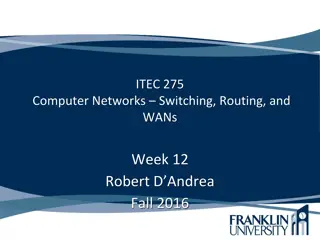Testing Network Design for Successful Implementation
Explore the importance of testing network designs to ensure they meet business and technical goals, validate technology selections, and identify potential optimization techniques. Learn about common errors at various network layers and industry testing services that can assist in verifying network functionality and performance.
Download Presentation

Please find below an Image/Link to download the presentation.
The content on the website is provided AS IS for your information and personal use only. It may not be sold, licensed, or shared on other websites without obtaining consent from the author.If you encounter any issues during the download, it is possible that the publisher has removed the file from their server.
You are allowed to download the files provided on this website for personal or commercial use, subject to the condition that they are used lawfully. All files are the property of their respective owners.
The content on the website is provided AS IS for your information and personal use only. It may not be sold, licensed, or shared on other websites without obtaining consent from the author.
E N D
Presentation Transcript
Network Governance SESSION 11 Testing the Network Design D5727 Dr. Eng. Nico Surantha, ST., MT.
OUTLINE 1. BUILDING AND TESTING A PROTOTYPE NETWORK SYSTEM WRITING AND IMPLEMENTING A TEST PLAN FOR YOUR NETWORK DESIGN TOOLS FOR TESTING A NETWORK DESIGN 2. 3.
Reasons to Test Verify that the design meets key business and technical goals Validate LAN and WAN technology and device selections Verify that a service provider provides the agreed- up service Identify bottlenecks or connectivity problems Determine optimization techniques that will be necessary Bina Nusantara University
Typical Layer 1 Errors Broken cables Disconnected cables Cables connected to the wrong ports Intermittent cable connection Wrong cables used for the task at hand Transceiver problems Devices turned off Bina Nusantara University
Typical Layer 2 Errors Improperly configured serial interfaces Improperly configured Ethernet interfaces Improper encapsulation set Improper clock rate settings on serial interfaces Network interface card (NIC) problems Bina Nusantara University
Typical Layer 3 Errors Routing protocol not enabled Wrong routing protocol enabled Incorrect IP addresses Incorrect subnet masks Bina Nusantara University
Testing Your Network Design Use industry testing services Build and test a prototype system Use third-party and Cisco tools Bina Nusantara University
Industry Testing Services Vendors, independent test labs, and trade journals offers network testing service For example The Interoperability Lab at the University of New Hampshire (IOL) ICSA Labs Miercom Labs KeyLabs The Tolly Group Bina Nusantara University
Industry Testing Services (2) Advantages: They have proven testing methodology Help to convince your customer of your design s effectiveness. Bina Nusantara University
Industry Testing Services (3) Weakness: The test result can be misleading vendors obviously make every effort to ensure that their products appear to perform better than their some trade journals and labs are also reluctant to publish negative results about vendors products because the vendors help pay their bills. most tests run by vendors, independent labs, and trade journals are component tests rather than system tests. the test configuration used by the vendor or testing lab almost certainly does not match your actual configuration. Bina Nusantara University
Industry Testing Services (4) To understand how network components will behave in your configuration with your applications, network traffic, and unique requirements, building a prototype system or model of the network is usually necessary. Bina Nusantara University
Building and Testing Prototype Network System Prototype : an initial implementation of a new system that provides a model on which the final implementation will be patterned. A prototype allows a designer to validate the operation and performance of a new system. Bina Nusantara University
Scope of a Prototype System It s not generally practical to implement a full- scale system A prototype should verify important capabilities and functions that might not perform adequately Risky functions include complex, intricate functions and functions that were influenced by the need to make tradeoffs Bina Nusantara University
Scope of a Prototype System (2) The scope of a network prototype can depend on both technical and nontechnical goals. Pay attention to nontechnical factors, such as your customer s biases, business style, and history with network projects Perhaps the customer already refused a network design because of its lack of manageability and usability features Bina Nusantara University
Scope of a Prototype System (3) A prototype can be implemented and tested in three ways: As a test network in a lab To develop initial device configurations To model predicted network performance and QoS To demonstrate design to a customer Integrated into a production network but tested during off hours Integrated into a production network and tested during normal business hours Bina Nusantara University
Components of a Test Plan Test objectives and acceptance criteria The types of tests that will be run Network equipment and other resources required Testing scripts The timeline and milestones for the testing project Bina Nusantara University
Test Objectives and Acceptance Criteria Specific and concrete Based on business and technical goals Clear criteria for declaring that a test passed or failed Avoid biases and preconceived notions about outcomes If appropriate, reference a baseline Bina Nusantara University
Test Objectives and Acceptance Criteria (2) Examples of specific objectives and acceptance criteria that were written for a particular customer: Measure the response time for Application XYZ during peak usage hours (between 10 a.m. and 11 a.m.). The acceptance criterion is that the response time must be half a second or less. Measure Application XYZ s throughput during peak usage hours (between 10 a.m. and 11 a.m.). The acceptance criterion is that throughput must be at least 2 Mbps. Bina Nusantara University
Types of Tests Application response-time tests Throughput tests Availability tests Regression tests Bina Nusantara University
Types of Tests (2) Application response-time tests: how much time a user must wait when executing typical operations that cause network activity. These operations include starting an application, switching between screens, forms, and fields within the application, and executing file opens, reads, writes, searches, and closes. With this type of testing, the tester watches actual users or simulates user behavior with a simulation tool. The test should start with a predetermined number of users and actions, and then gradually increase the number of users and actions Bina Nusantara University
Types of Tests (3) Throughput testing To measure throughput for a particular application and throughput for multiple applications in kilobytes or megabytes per second. It can also measure throughput in terms of packets per second through a switching device (for example, a switch or router). The test should start with a predetermined number of users and actions, and then gradually increase the number of users and actions Bina Nusantara University
Types of Tests (4) Availability testing: With availability testing, tests are run against the system for 24 hours to 72 hours, under medium to heavy load. The rate of errors and failures is monitored. Regression testing Regression testing makes sure the new system doesn t break any applications or components that were known to work and perform to a certain level before the new system was installed. Regression testing does not test new features or upgrades. Instead, it focuses on existing applications. Regression testing should be comprehensive and is usually automated to facilitate comprehensiveness. Bina Nusantara University
Resources Needed for Testing Scheduled time in a lab either at your site or the customer s site Power, air conditioning, rack space, and other physical resources Help from coworkers or customer staff Help from users to test applications Network addresses and names Bina Nusantara University
Example Test Script Workstations Server 1 Firewall Network A Network B Protocol Analyzer Protocol Analyzer Test environment Bina Nusantara University
Example Test Script (continued) Test objective. Assess the firewall s capability to block Application ABC traffic, during both light and moderately heavy load conditions. Acceptance criterion. The firewall should block the TCP SYN request from every workstation on Network A that attempts to set up an Application ABC session with Server 1 on Network B. The firewall should send each workstation a TCP RST (reset) packet. Bina Nusantara University
Example Test Script (continued) 1. Start capturing network traffic on the protocol analyzer on Network A. Start capturing network traffic on the protocol analyzer on Network B. Run Application ABC on a workstation located on Network A and access Server 1 on Network B. Stop capturing network traffic on the protocol analyzers. Display data on Network A s protocol analyzer and verify that the analyzer captured a TCP SYN packet from the workstation. Verify that the network layer destination address is Server 1 on Network B, and the destination port is port 1234 (the port number for Application ABC). Verify that the firewall responded to the workstation with a TCP RST packet. 2. 3. 4. 5. Bina Nusantara University
Example Test Script (continued) 6. Display data on Network B s protocol analyzer and verify that the analyzer did not capture any Application-ABC traffic from the workstation. Log the results of the test in the project log file. Save the protocol-analyzer trace files to the project trace-file directory. Gradually increase the workload on the firewall, by increasing the number of workstations on Network A one at a time, until 50 workstations are running Application ABC and attempting to reach Server 1. Repeat steps 1 through 8 after each workstation is added to the test. 7. 8. 9. Bina Nusantara University
Tools for Testing a Network Design Network-management and monitoring tools Traffic generation tools Modeling and simulation tools QoS and service-level management tools http://www.topdownbook.com/tools.html Bina Nusantara University
Conclusion An untested network design probably won t work It s often not practical to test the entire design However, by using industry testing services and tools, as well as your own testing scripts, you can (and should) test the complex, risky, and key components of a network design Bina Nusantara University
DAFTAR PUSTAKA/SUMBER Oppenheimer, Priscilla. (2013). Top Down Network Design. 3rd Edition. Cisco Press. Indianapolis. ISBN: 978-1-58705- 152-4. Hummel, S. L. (2015). Cisco Design Fundamentals: Multilayered Network Architecture and Design for Network Engineers.
Thank You Thank You























